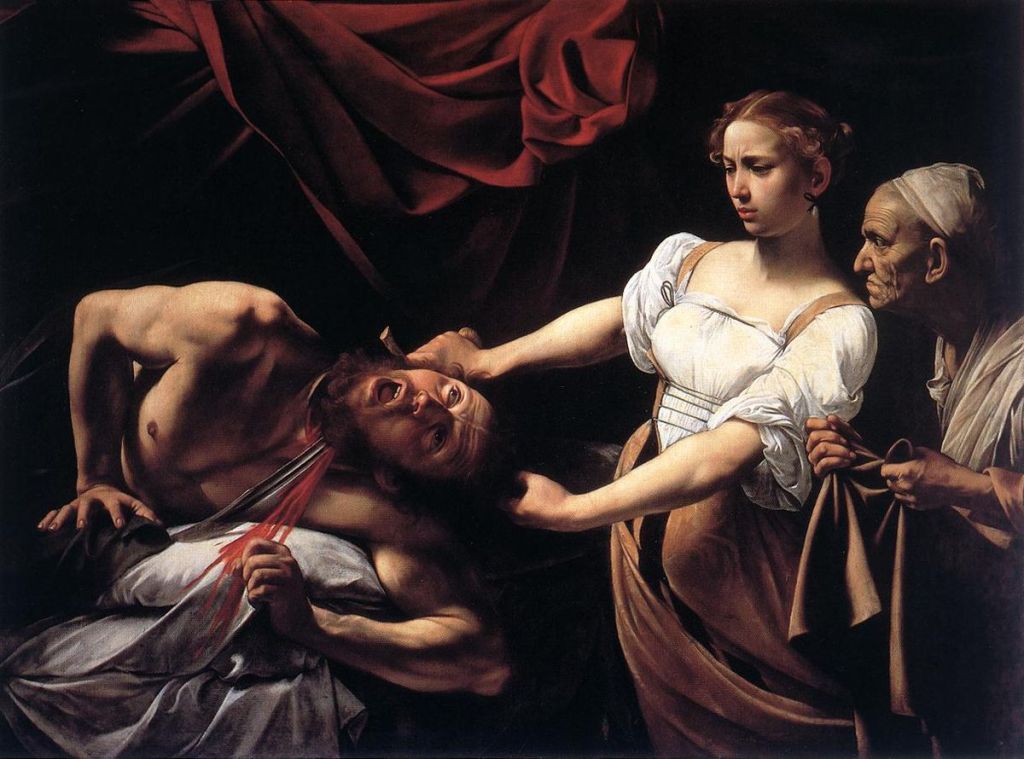Judith Beheading Holofernes
In the blog’s introduction I warned the reader of my bias towards Italian art. What I meant to say is that Caravaggio is my favourite painter and that I will relentlessly write about him and his works. I thought this painting would be relevant as I saw it while on holiday in Rome last month, and I feel an irresistible urge to write about it. It is one of my favourite paintings and seeing it in the flesh was a highlight of the holiday. It was larger than I expected, and brighter. But what struck me most was that it seemed to move, to breathe, and I spent about five minutes standing in front of it.
The book of Judith (not a part of the Hebrew Bible but considered by Catholics as canonical) tells the story of a beautiful widow, who kills the Assyrian general leading an army to conquer her hometown of Bethulia. Holofernes (whose name means ‘stinking hell’) was sent by Nebuchadnezzar, the tyrannical King of Babylon, to destroy the town because it resisted his rule. The army cut off the water supply and lay siege to it. After 34 days the townspeople meet and decide to yield, thinking that God has abandoned them. But Judith has a secret plan, a last desperate attempt at hope. ‘She took off the sackcloth and her widow’s clothes, took a bath, and put on rich perfumes. She brushed her hair, tied a ribbon around it, and dressed herself in the fine clothes she used to wear on joyful occasions…She made herself so beautiful that she was sure to attract the attention of any man who saw her.’ (Judith 10:4-5). She and her maid leave Bethulia and she seeks Holofernes, aware of her beauty and seeking to seduce him. After a banquet she is left alone with the general, who is in a drunken stupor, and she takes her chance. She hacks his head off with his own sword, her maid on hand for moral support. They take the head and put it on the city wall, and Judith declares ‘my beauty deceived him and brought him to his ruin’ (Judith 10:17). Thus the army flee and the town is saved from the invaders. She acts in God’s name and is regarded as a heroine. It is a story of triumph over evil, much like that of David and Goliath, except the hero is a woman who uses beauty and intelligence to defeat the enemy.
This painting like most of Caravaggio’s captures a moment, a snapshot into a pivotal scene where the drama is at its pinnacle. Judith with tensed muscular arms, a sword in one hand, a fistful of her victim’s hair in the other, is delivering the final slice through Holofernes’ neck. He, whose face shows his final emotion of realisation and shock, looks up at his murderess, gasping his last breath. In contrast Judith’s face is calm, she is concentrating and her eyes are focused on the task. She is determined, encouraged by her handmaid, who’s lined and haggard face further emphasises Judith’s radiant beauty. It seems strange to say, but as I stood before this painting it seemed to be alive. I felt immersed in the scene, the tension and emotion is strikingly believable. I felt as though I could sense breathing of the figures. Holofernes gasps desperately, a sharp intake which fails to reach his lungs, while Judith releases a steady exhalation. It is audible. I love the look of resolve on her face; she is graceful and fearless, she exudes virtue and verve. The balance of the characters is masterful. The crisp white sheet and blood-red hangings create a symbolic background further heightening the drama.
There have been many interpretations of this scene throughout art, but this was totally original at the time. It inspired future artists tackling the subject and Caravaggio’s version was often used as a template. Being the controversial artist that he was Caravaggio used Rome’s most desirable courtesan, Fillide Melandroni, as a model for Judith. She can also be seen in St Catherine (c.1598) and as Mary in Martha and Mary Magdalene (c.1598) of around the same time. The year Judith Beheading Holofernes was created Caravaggio is likely have witnessed a public execution. Beatrice Cenci was a young noblewoman who along with her stepmother and siblings was beheaded for murdering Francesco Cenci, her abusive father. She became a legend because of her actions against her sinful father and an inspiration for a protagonist throughout art, literature and theatre.
This painting is enduring because of its immediacy, its theme of religious victory and its gruesome realism. An intelligent, respected, and most importantly, beautiful widow uses her God-given assets to save her fellow citizens from the threat of the evil infidel. Holofernes is weak because he is a heathen, because he desires Judith. And all this in three figures and a bit of drapery.

